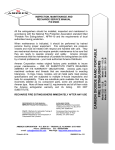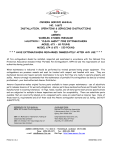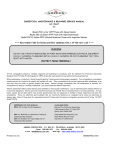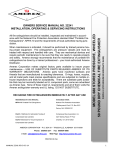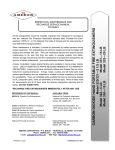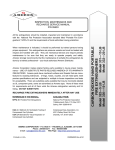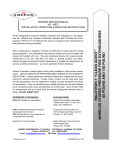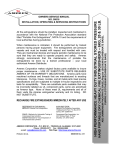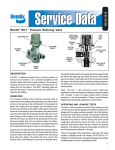Download OWNERS SERVICE MANUAL
Transcript
OWNERS SERVICE MANUAL NO. 05618 INSTALLATION, OPERATING & SERVICING INSTRUCTIONS for AMEREX CARBON DIOXIDE MODEL 333 50 POUND WHEELED MODEL 334 100 POUND WHEELED MODEL 335 100 POUND STATIONARY * * * RECHARGE FIRE EXTINGUISHERS IMMEDIATELY AFTER ANY USE * * * All fire extinguishers should be installed, inspected and maintained in accordance with the National Fire Protection Association standard titled "Portable Fire Extinguishers", NFPA-10 and the requirements of local authorities having jurisdiction. When maintenance is indicated it should be performed by trained persons having proper equipment. Fire extinguishers are pressure vessels and must be treated with respect and handled with care. They are mechanical devices and require periodic maintenance to be sure that they are ready to operate properly and safely. Amerex strongly recommends that the maintenance of portable fire extinguishers be done by a trained professional – your local authorized Amerex Distributor. Amerex Corporation makes original factory parts available to insure proper maintenance – use of substitute parts releases Amerex of its warranty obligations. Amerex parts have machined surfaces and threads that are manufactured to exacting tolerances. O-rings, hoses, nozzles, and all metal parts meet precise specifications and are subjected to multiple in-house inspections and tests for acceptability. There are substitute parts available that are incorrectly labeled as UL component parts, some are advertised as Amerex type. None of these meet UL requirements and all of them voids the Amerex extinguisher warranty and UL listing. DO NOT SUBSTITUTE. REFERENCES IN THIS MANUAL: NFPA-10 Portable Fire Extinguishers AVAILABLE FROM: National Fire Protection Association 1 Batterymarch Park, P. O, Box 9101 Quincy, MA 02269-9101 CGA C-1 Methods for Hydrostatic Testing of Compressed Gas Cylinders CGA C-6 Standard for Visual Inspection of Compressed Gas Cylinders Compressed Gas Association, Inc. 4221 Walney Road, 5th Floor Chantilly, VA 20151-2923 AMEREX CORPORATION – P.O. BOX 81 – TRUSSVILLE, ALABAMA 35173-0081 Phone: 205/655-3271 Fax: 800/654-5980 e-mail: [email protected] Web Page: http://www.amerex-fire.com Printed in U.S.A. 0M05618 Rev 9/05 LIMITED WARRANTY Amerex warrants its fire extinguishers to be free from defects in material and workmanship for a period of six (6) years from the date of purchase. During the warranty period, any such defects will be repaired or the defective extinguisher replaced if the original grey lockwire seal is intact and/or if only factory replacement parts and recommended service equipment have been used to service the extinguisher. This warranty does not cover defects resulting from the modification, alteration, misuse, exposure to unusually corrosive conditions nor improper installation or maintenance. All implied warranties, including but not limited to, warranties of fitness for purpose and merchantability, are limited to the time periods as stated above. In no event shall Amerex Corporation be liable for incidental or consequential damages. Some states do allow limitations on how long an implied warranty lasts or the exclusion or limitation of incidental or consequential damages, so that the above limitations or exclusions may no apply to you. Amerex Corporation neither assumes nor authorizes any representative or other person to assume for it any obligation or liability other than as expressly set forth herein. This warranty gives you specific legal rights, and you may also have other rights which vary from state to state. To obtain performance of the obligation of this warranty, write to Amerex Corporation, P. O. Box 81, Trussville, AL 35173-0081 for instructions. THIS MANUAL IS ATTACHED TO EVERY NEW EXTINGUISHER SHIPPED FROM THE FACTORY. IT CONTAINS VALUABLE INFORMATION WHICH SHOULD BE STUDIED BY EVERYONE WHO WILL USE OR SERVICE THE EXTINGUISHER. THE MANUAL SHOULD BE STORED IN A CONVENIENT LOCATION FOR EASY REFERENCE. PREPARING YOUR NEW EXTINGUISHER FOR USE 1. Remove all wrappings, straps and pallet retaining bolts. 2. Examine the extinguisher for shipping damage. 3. Remove shipping cap(s) from CO2 cylinder(s). Install discharge hose (50 lb.) or manifold (100 lb.) to cylinder valve(s). check to insure that the hose connection to the operating valve/or manifold and hose to the squeeze grip shut-off valve are tight. 4. Check to insure that the cylinder valve(s) are in the CLOSED position. The ring (locking) pin should be installed and the lockwire seal intact. 5. Visually inspect t he safety relief on the cylinder valve for evidence of obstruction or damage. DO NOT REMOVE. 6. This extinguisher is shipped from the factory fully charged. The most accurate method to determine if the extinguisher is filled with the proper amount of Caron Dioxide is to weigh the unit. The gross weight is indicated on the lower right hand corner of the pictogram operation INSTRUCTIONS (plus weight of cylinders stamped on cylinder valve{s}), 7. Record the date the unit is being placed into service on the inspection tag and attach it to the extinguisher. INSTALLATION Do not place this extinguisher close to a potential fire hazard. Amerex recommends location no less than a 20 foot distance from the hazard while leaving an unobstructed access. Avoid placing it in an extremely hot or cold place. The operational temperature range for this e xt i n g ui she r is –40°F to 120°F (-40°C to 49°C). The extinguisher should be adequately protected if temperatures outside of this range are anticipated. Keep the extinguisher clean and free from dirt, ice, chemicals and any contaminants that may interfere with its proper operation. DO NOT FUNCTIONALLY TEST THIS FIRE EXTINGUISHER. (Testing or any use may cause the extinguisher to gradually lose extinguishing agent over a period of time and make the extinguisher ineffective.) OPERATION WARNING: HIGH CONCENTRATIONS OF CARBON DIOXIDE CAN CAUSE RESPIRATORY PROBLEMS. SELF CONTAINED BREATHING APPARATUS OR AIR LINE RESPIRATORS SHOULD BE USED IF OXYGEN LEVEL HAS BEEN DIMINISHED BELOW 19%. AVOID SKIN CONTACT – CO2 IS VERY COLD AND COULD CAUSE BURNS OR FROSTBITE. CAUTION: Persons expected to use this extinguisher should be trained in initiating its operation and in the proper fire fighting technique. "Hands on" training will prepare personnel with the feel for this extinguisher so that the most effective application can be utilized in an emergency situation. The basic operating instructions are contained in the pictogram portion of every extinguisher nameplate (label). The following elaborates on these instructions. 1 1. Move the extinguisher (wheeled unit) to within approximately 10 feet (50 lb.), 30 feet (100 lb.) of the fire site. 2. Twist and pull ring pin(s). Pull “T” handle cylinder valve lever(s) to open cylinder valve. Pull hose from rack. Start back 10 feet from the fire. 3. Grasp horn squeeze grip shut-off valve and aim horn at base of fire nearest you. 4. Squeeze horn shut-off valve lever. Sweep side to side across the base of the fire and past both edges. Progressively follow up until the fire is extinguished. Work the fire away from you while being alert for flashbacks. Move closer as the fire is extinguished but not so close as to scatter or splash the burning material. 5. When the fire is out, release the horn shut-off valve lever to stop discharge. Stand by and watch for possible re-ignition. 6. Evacuate and ventilate the area immediately after extinguishing the fire. The fumes and smoke from any fire may be hazardous and can be deadly. Discharge Time (approx.) Hose Length 50 LB. 44 seconds ±5 sec. 15 feet 100 LB. 74 seconds ±8 sec. 40 feet BEFORE PREPARING TO MOVE THE EXTINGUISHER TO THE RECHARGE LOCATION DETERMINATION MUST BE MADE THAT THE FIRE IS COMPLETELY EXTINGUISHED AND THERE IS NO DANGER OF A FLASHBACK. HAVE EXTINGUISHER RECHARGED IMMEDIATELY AFTER ANY USE SHUTDOWN 1. Push cylinder valve “T” handle(s) to the closed position and install ring (locking) pin. Squeeze nozzle shut-off valve to release any carbon dioxide remaining in the hose. 2. When all pressure has been evacuated from the hose, remove hose (50 lb.) or manifold (100 lb.) from cylinder valve(s). Install shipping cap(s) to protect valve assembly. Coil the extinguisher hose onto the storage rack and position the nozzle onto the mount in preparation for transport to the recharge location. AMEREX CORPORATION DOES NOT SERVICE, MAINTAIN OR RECHARGE FIRE EXTINGUISHERS. THIS MANUAL IS PUBLISHED AS A GUIDE TO ASSIST QUALIFIED SERVICE PERSONNEL IN THE INSPECTION, MAINTENANCE AND RECHARGE OF AMEREX FIRE EXTINGUISHERS ONLY. NO INSTRUCTION MANUAL CAN ANTICIPATE ALL POSSIBLE MALFUNCTIONS THAT MAY BE ENCOUNTERED IN THE SERVICE OF FIRE EXTINGUISHERS. DUE TO THE POSSIBILITY THAT PRIOR SERVICE PERFORMED ON THIS EQUIPMENT MAY HAVE BEEN IMPROPERLY DONE, IT IS EXTREMELY IMPORTANT THAT ALL WARNINGS, CAUTIONS AND NOTES IN THIS MANUAL BE CAREFULLY OBSERVED. FAILURE TO HEED THESE INSTRUCTIONS COULD RESULT IN SERIOUS INJURY. AMEREX ASSUMES NO LIABILITY FOR SERVICE, MAINTENANCE OR RECHARGE OF FIRE EXTINGUISHERS BY PUBLISHING THIS MANUAL. INSPECTING THE EXTINGUISHER INSPECTION [NFPA-10] is a "quick check" that a fire extinguisher is available and is in operating condition. It is intended to give reasonable assurance that the fire extinguisher is fully charged. This is done by verifying that it is in its designated place, that it has not been actuated or tampered with, and that there is no obvious physical damage or condition to prevent its operation. PERIODIC INSPECTION PROCEDURES (monthly or more often if circumstances dictate) 2 [NFPA-10] A “quick check” should be made of the extinguisher for the following: 1. 2. 3. 4. 5. 6. 7. 8. Located in designated place No obstruction to access or visibility Operating instructions on nameplate legible and facing outward Seals and tamper indicators not broken or missing Determine fullness by weighing Examination for obvious physical damage, corrosion, leakage, or clogged nozzle or horn obstruction Condition of tires, carriage and hose MAINTENANCE Maintenance [NFPA 10] At least once a year (or more frequently if indicated by an inspection) Maintenance should be performed. Maintenance is a thorough examination of the fire extinguisher. It is intended to give maximum assurance that a fire extinguisher will operate effectively and safely. It includes a thorough examination for physical damage or condition to prevent its operation and any necessary repair or replacement. It will normally reveal if hydrostatic testing or internal maintenance is required. MAINTENANCE PROCEDURE NOTE: This procedure will be best accomplished with the extinguisher in an upright position on a level surface. 1. Clean extinguisher to remove dirt, grease or foreign material. Check to make sure that the instruction nameplate and UL manifest are securely fastened and legible. Inspect the cylinder for corrosion, abrasion, dents or weld damage. If any of these conditions are found and you doubt the integrity of the cylinder, hydrostatically test to factory test pressure, using the proof pressure method in accordance with CGA C-6 and NFPA 10. Properly dispose of cylinder if in violation of the standard. 2. Inspect the extinguisher for damaged, missing or substitute parts. Only factory replacement parts are approved for use on Amerex fire extinguishers. 3. Check the date of manufacture on the extinguisher cylinder dome. Cylinder must be hydrostatically tested every 5 years to the test pressure indicated on the nameplate (3000 psi [20.69 MPa]). Note: Complete maintenance should be performed whenever a hydrostatic test is being done. This includes an inspection of the interior of the valve assembly, the spring and valve stem assembly, as well as the interior of the cylinder. 4. Remove ring (locking) pin and check for freedom of movement. Replace if bent or if removal appears difficult. 5. Check the horn shutoff lever for freedom of movement (squeeze and release several times). If the operation is impeded, disassemble the nozzle, replace parts and/or properly lubricate as necessary. Make sure that the horn is clear and unobstructed. WARNING: SQUEEZE HORN SHUT-OFF LEVER SLOWLY. CARBON DIOXIDE MAY HAVE BEEN LEFT IN THE HOSE FROM A PREVIOUS DISCHARGE. BE PREPARED FOR A POSSIBLE DISCHARGE AND NOZZLE RECOIL. 6. Remove the hose and horn and inspect for damage. Replace the hose if cut or cracked, or if threaded couplings are damaged. Replace the horn if brittle, cracked or deformed. Blow air through the hose and nozzle assemblies to insure that the passage is clear of foreign material. CAUTION: Carbon dioxide hose assemblies have a continuous metal braid that connects to both couplings to minimize static shock. A hose continuity test should be performed using a basic conductivity 3 tester consisting of a flashlight having an open circuit and a set of two wires with a conductor (clamps or probe) at each end. (NFPA-10 Appendix A). NOTE: Carbon dioxide hose assemblies require hydrostatic testing every 5 years to the same test pressure as the cylinder (3000 psi [20.69 MPa]). 7. Inspect cylinder valve assembly for corrosion or damage to hose thread connection. Visually inspect the safety disc assembly for obstruction or damage. Valve removal and/or valve part replacement should be made only after completely discharging the contents of the cylinder. 8. Inspect the wheels to insure they rotate freely. Lubricate as required. 9. Check carriage assembly for loose nuts, bolts, frame distortion or damage. Check welds for damage or corrosion. Replace damaged parts or make repairs as necessary. 10. Reinstall horn to shut-off valve and valve to hose. Reconnect the hose to the agent cylinder. Properly coil the hose on the rack and horn in the clips. 11. Weigh extinguisher and compare with weight printed on the Pictogram operating instruction on the label (plus the weight of the cylinder(s) stamped on the cylinder valve(s). recharge extinguisher if weight is not within indicated allowable tolerances (more than 5 lbs. per cylinder). 12. Install new tamper seal and record service data on the extinguisher inspection tag. 13. If the extinguisher has been moved to perform service, make sure that it is returned to its proper location. RECHARGE RECHARGING [NFPA-10] is the replacement of the extinguishing agent . RECHARGING PROCEDURE WARNING: Before attempting to recharge be sure the extinguisher is completely empty and depressurized. Use only an approved source of carbon dioxide (see minimum specifications in NFPA-10 Chapter 4 Inspection, Maintenance and Recharging). Do not use dry ice converters. Use an approved pump, hose and recharge adapter to insure safe and efficient recharge operations. 1. Perform steps 1 thru 10 of the Maintenance procedure. 2. Discharge all remaining carbon dioxide from the extinguisher. NOTE: The Model 334 & 335 (100 lb.) extinguishers have two 50 lb. cylinders manifolded to a common discharge hose. The manifold must be removed before attempting to recharge the cylinders. 3. Place 50 lb. cylinder on an accurate scale (the full weight – cylinder, valve and CO2 is stamped on the valve). Install recharge adapter. Connect carbon dioxide supply line to the recharge adapter. 4. Move “T” handle on the cylinder valve to the open position and pump 50 lbs. (22.7 KG) of clean, dry carbon dioxide into the cylinder. 5. When the proper weight is reached, move the “T” handle on the cylinder valve to the closed position. Shut off CO2 pump and vent supply line. 6. Remove the CO2 supply line and recharge adapter from the cylinder valve. . 7. Check for leaks using leak detection fluid or a solution of soapy water. If any leaks occur, refer to the Troubleshooting Guide. 8. Install ring (locking) pin and lockwire seal on cylinder valve(s). Attach new recharge tag. 9. Install cylinder(s) to the carriage and properly secure. 10. Attach the hose and horn assembly to the cylinder valve. Install hose and horn assembly on carriage. 4 CAUTION: The Models 334 and 335 extinguishers have two 50 lb. cylinders manifolded to a common discharge hose. Properly align the cylinders, then attach manifold hoses with manifold and discharge hose and horn assembly to the cylinder valves. 11. Weigh assembled extinguisher and confirm that the total weight is within the allowable tolerances indicated on the pictogram operating instructions (plus weight of cylinder[s] stamped on cylinder valve[s]). 5 TROUBLE SHOOTING GUIDE WARNING: BEFORE ATTEMPTING TO CORRECT ANY LEAKAGE PROBLEM, BE SURE THAT THE CYLINDER AND HOSE ARE COMPLETELY EMPTY AND DEPRESSURIZED. NOTE: Check to determine the source of a leak before the extinguisher is emptied. Leakage repairs will require that the Carbon Dioxide cylinder be completely empty and the valve assembly removed. When reinstalling the cylinder valve assembly, the cylinder must be placed in a suitable securing vice and valve installed to 150 ft. lbs. of torque. 1. 2. 3. 4. 5. 6. PROBLEM Leak at valve to cylinder connection Leak through valve CORRECTIVE ACTION Remove valve assembly, install new Teflon sealing tape, reinstall valve to a maximum of 150 ft. lbs. torque. Remove valve assembly, downtube, spring and valve stem assembly. Install new valve stem assembly. Check valve seat for scratches or foreign matter. Leak at safety relief nut Remove safety nut, disc and gasket assembly. Replace with new Amerex P/N 04000 safety nut, disc and gasket assembly. Tighten assembly to 250 in. lbs. of torque. Leak at base of “T” handle on Remove valve assembly, downtube, spring and valve cylinder stem valve. assembly. Install new valve stem assembly. Check valve seat for scratches or foreign matter. Leak at any hose connections Tighten hose connections and check for hose coupling damage. Replace hose assembly as necessary. Leak in the cylinder Contact Amerex if under warranty, otherwise mark “REJECTED” and return to owner. NOTE: When valve removal is performed at hydrotest, the cylinder neck threads must be examined per CGA C-6. “Cylinders shall be rejected if the required number of effective threads is materially reduced so that a gas tight seal cannot be obtained by reasonable valving methods. Common defects are worn or corroded crests and broken or nicked threads.” 6 Item No. 1 1A 1B 2 2A 2B Part No. 09891 09903 17209 09618 09787 17304 10234 3 3A 07751 04945 4 Description Carriage Asy w/o wheels – 333 Carriage Asy w/o wheels – 334 Frame Asy - 335 Pictogram – 333 Pictogram – 334 Pictogram – 335 Wheel Asy – 16” w/hubcap, washers & retaining pin-full pneumatic “ -semi pneumatic Std. Pkg. 1 Hub Cap 1 1 12470 Cap – Valve Protector 1 5 06373 Valve Lever (“T” handle w/roll pin & knobs) 1 6 04000 Safety Disc, Gasket & Nut Asy 6 7 09897 Valve Stem Asy 6 8 00501 Spring 6 9 09627 Retainer 1 10 09623 Downtube 1 11 06100 Ring Pin, Stainless Steel w/Wire 12 12 01387 Lockwire Seal (Yellow) 500 13 09895 Valve Asy Complete w/downtube 1 14 17301 Plastic Plug 2 15 09892 Horn Clip w/Mounting Hardware 1 16 09893 1 16A 17 17A 09904 09380 09396 09365 09545 Cyl Restraining (Saddle) straps w/ Mounting Hardware – 333 “ -334 & 335 Horn Holder – 333 “ - 334 &335 Hose Asy – 333 – 15 ft. Hose Asy – 334 & 335 – 40 ft. 19 09366 Shut-off Valve Asy 1 20 09899 Vlv Stem Asy for Shut-off Valve 6 21 09901 Spring for Shut-off Valve 6 22 09896 Handle w/Rubber Cover 1 23 09369 Horn & Nozzle 1 24 08169 Union (Manifold) – 334 & 335 1 25 09905 Manifold (w/Union) – 334 & 335 1 18 PARTS LIST for 50 and 100 lb. Carbon Dioxide Extinguishers Model 333 - 50 lb. Model 334 – 100 lb. (Two 50 lb. Cylinders) Model 335 – 100 lb. Stationary 1 1 1 1 1 1 1 7









